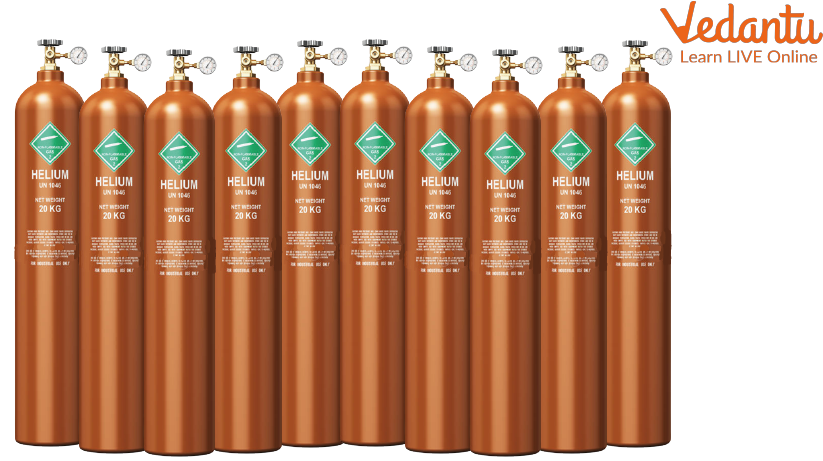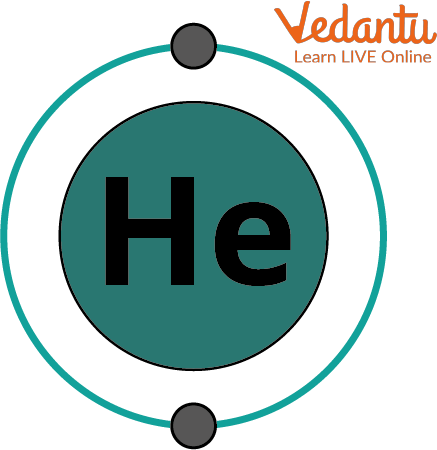




An Introduction to the World of Helium
Kids love to play with balloons. There are numerous kinds of balloons these days. But have you noticed some balloons fly in the air and some remain on the floor? Have you ever thought about what makes balloons fly or remain erect in the air? This is because of the helium gas present in the balloons which keeps balloons floating in the air and what it looks like is shown in the picture below.

Floating Balloons
Helium is a very light colourless gas that does not burn and thus is non-flammable as it is safe. It is often used to fill objects that float in the air. It is a chemical element of the noble gas group found especially in natural gases. Helium gas is used in numerous things. It is also used in oxygen cylinders. Let us learn more about helium.

Helium-Oxygen Cylinders
General Properties of the Helium Gas
Helium is colourless, odourless, and tasteless gas. Also, it is non-toxic in nature. This gas has low chemical reactivity. Moreover, it has the lowest boiling point as compared to other gases. The symbolic representation of this gas is as He and belongs to group 18. It also has the lowest freezing point.
Helium is considered to be lighter than air and is very important in its applications. This gas is also unreactive in nature and has the ability to conduct heat. The symbol of helium is as follows.

Symbol of Helium
Is Helium a Metal or Nonmetal?
Helium is non-metallic in nature. It is the second element in the periodic table. Helium is one of the most common elements in the entire universe. Helium lacks the characteristics of metal and thus is a non-metal. Also, it behaves as a superfluid that can even flow upward against the law of gravity. Helium does not have the capacity to donate electrons and is placed on the extreme right side in a periodic classification, thus proving to be non-metallic in nature.

Helium Place in the Periodic Table
Physical and Chemical Properties of Helium
The physical properties of helium are as follows:
All the noble gases are monatomic.
Helium is colourless, odourless, and tasteless.
It is sparingly soluble in water
Helium has the lowest boiling point of any known substance.
Even it has a low melting and boiling point.
The chemical properties are as follows:
In general, noble gases are the least reactive due to the following reasons:
Helium has high ionisation enthalpy.
It has low boiling and melting point and is colourless in nature
It can be liquefied under very high pressure and very low temperature.
Also, helium has a melting point of 0.95K and a boiling point of 4.222k.
Interesting Facts about Helium for Kids
Helium is the second most abundant element in the universe and is the second lightest element.
The sun produces 700 million tons of helium per second.
The name helium is derived from the Greek word meaning sun.
Helium was available in the market in 1928.
Earth’s gravity is not strong enough to hold this gas.
Let’s Summarise
This was the discussion about helium. We have learnt that helium is a very vital gas and is used in various applications. We can say that as being unreactive, it is used to make fibre optics and also used in the manufacturing of semiconductors. It is also essential to detect leaks in-car air conditioning systems and even in homes. Helium is also used in medicines to aid patients with lung diseases.
FAQs on Is Helium Flammable? Helium for Kids
1. Is helium flammable?
No, helium is not flammable. It is a very stable and unreactive element, often called a noble gas. This means it will not catch fire or react with other substances, making it very safe to use in products like party balloons.
2. What makes helium special for kids to learn about?
Helium is a fascinating gas with several special properties that are easy for kids to understand. Here are a few key points:
- It is much lighter than air, which is why it makes balloons float upwards.
- It is a completely invisible gas with no colour, no smell, and no taste.
- Helium is non-toxic and non-flammable, which is why it's the safest gas for filling balloons.
- It has the second lowest atomic number on the periodic table, right after hydrogen.
3. Why are party balloons filled with helium and not just air?
Balloons are filled with helium because helium gas is significantly lighter than the air around it. This difference in density creates lift, causing the balloon to float upwards. If you fill a balloon with regular air from your lungs or a pump, it will just drop to the floor because the air inside is just as heavy as the air outside.
4. Is helium gas safe for kids to be around?
Helium gas itself is non-toxic and safe to be around in an open environment, like when it is used in balloons at a party. However, it is extremely dangerous to inhale helium directly from a balloon or tank. Breathing in helium displaces the oxygen your body needs, which can lead to dizziness, fainting, and even serious brain injury or death from lack of oxygen.
5. If hydrogen is also lighter than air, why isn't it used in balloons instead of helium?
While it's true that hydrogen is even lighter than helium, it is highly flammable and explosive when it comes into contact with a spark or flame. In the past, hydrogen was used in airships, but its dangerous nature led to disasters. Helium, being completely unreactive and non-flammable, is a much safer choice for balloons and other uses where safety is important.
6. How can helium be a gas if it has a very low boiling point?
Helium exists as a gas at everyday temperatures on Earth precisely because its boiling point is so incredibly low (-269°C). For any substance to be a liquid or a solid, it needs to be cooled below its boiling and melting points. Since Earth's normal temperatures are far above helium's boiling point, we only ever encounter it as a gas unless it is cooled down in a special laboratory.
7. What are some fun facts about helium?
Here are some fun facts about the element helium:
- It was first discovered by scientists studying the Sun before it was found on Earth.
- Helium is the second most abundant element in the entire universe.
- Besides making balloons float, liquid helium is used as a super-coolant for powerful magnets in things like MRI machines.
- Helium is one of the few elements that will not turn into a solid just by cooling it; it also needs high pressure.









